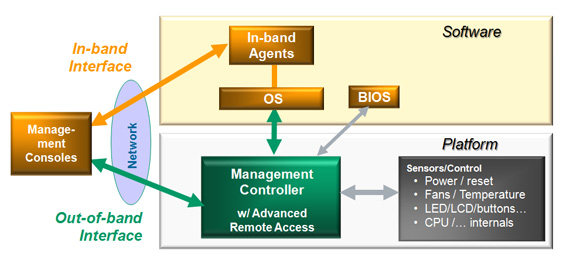Intel vPro: Three Generations Of Remote Management
It's common to manage PCs remotely in today's business environment. Intel's vPro technology aims to simplify that task by giving IT professionals hardware-level tools to make remote management easier. Today we look at three generations of vPro.
AMD's DASH Wild Card
The original aim of this piece was to compare successive generations of Intel’s vPro technology in order to track how the feature suite has evolved over the past several years. After all, Intel has more history in remote desktop management tools than any other company.
But before we button this one up, we wanted to get AMD’s input and feedback to see if it had its own plans to enable remote manageability across its desktop processor and chipset portfolio. As it turns out, AMD is working with an industry consortium called DMTF (Distributed Management Task Force) on a standard you’ve probably heard of called DASH (Desktop and Mobile Architecture for System Hardware).
Now, the company launched its Business Class technology for desktops back in 2009 hoping to enable an infrastructure of processors, chipsets, and graphics cards similar to what Intel has in its vPro lineup, hoping it'd be well-suited to SMB installations. Because it didn’t have its own networking technology, it relied on third-party network controller vendors to enable out-of-band manageability. Since then, the company has continued honing its implementations, and AMD is now on its fifth revision of plug-ins for Microsoft’s System Center Configuration Manager, which facilitates the configuration of DASH-compliant hardware.
Of course, the benefit of AMD’s approach is that DASH is an open standard. There’s a long list of board members that belong to DMTF (even Intel is listed), participating in its evolution. According to company representatives, OEMs were willing to back the standard because they didn’t have any control over vPro. There was no way to customize it or to add functionality, which they thought inhibited innovation.
As Intel’s AMT evolved, it eventually picked up DASH support as well (after AMT 5.0, according to posts on the company’s software blogs). Especially now, AMD sees this as a boon because IT support staff can manage Intel and AMD platforms side by side in a very similar way. What you have to remember, though, is that vPro and AMT expose a number of features that you simply can’t get through DASH. Remote KVM, for instance, isn’t yet possible through DASH—principally because Broadcom doesn’t support it yet through its controller. There are also no provisions for managing remote clients that are networked wirelessly, though AMD says there haven’t been many customer requests for such a feature. AMD says it’s able to offer a capability very similar to Anti-Theft technology, which works with some of the same ISVs (like Absolute Software’s Computrace). But Intel’s advantage is that customers can use an SMS message to brick a machine.
Here’s another cool characteristic of DASH: AMD’s Valerie Kane says support is independent of its CPUs, APUs, or chipsets. So, whereas vPro exacts some fairly specific requirements, you could potentially see a wider variety of AMD configurations with DASH support. More critical to compliance is the Broadcom networking hardware with manageability support built-in.
And then the story comes to a somewhat screeching halt. Where does an enthusiast buy a motherboard with DASH support? He doesn’t. There used to be a couple models out there, but they didn’t sell well, so successive boards with newer chipsets didn’t pick up support. How about system integrators looking to build DASH-capable machines for SMB customers? Sorry, no dice there, either. You’d really have to go through a tier-one vendor to find a DASH-enabled machine.
Get Tom's Hardware's best news and in-depth reviews, straight to your inbox.
And so, while we’re working with AMD to, perhaps, report in when a consumer board becomes available, there’s really no way to set up a story like this one using AMD-based hardware. An enthusiast or system builder interested in remote management really only has one game in town. When that changes, AMD knows we’re interested and its reps committed to letting us know.
Current page: AMD's DASH Wild Card
Prev Page Intel vPro, McAfee, And The Atom Platform-
cngledad Can I suggest an article comparing different remote access tools we can use? From the freeware TeamViewer, VNC Viewer to such things like WebEx? I think that would be a very good topic.Reply -
One correction: DQ57TM *does* contain a v1.2 TPM, the same as found on DQ67SW and DQ67EP. It's required to be vPro compliant (necessary for Intel TXT).Reply
-
jhansonxi Nifty but I don't like the single-vendor lock-in. I can see real improvements in IT efficiency if this was combined with AoE. Would like to see SSH support, however.Reply -
extremepcs Hopefully they have improved the activation mechanism. Kind of a PITA if you don't buy a certificate from a trusted CA. I used an internal cert and had to activate each machine by booting from a flash drive.Reply -
chovav If my hard drive is encrypted using TrueCrypt pre-boot authentication, would I be able to fill in the password using Intels vPro?Reply -
jowunger The voice of the guy in the video is bad. The guy talks like he is speedreading a book...Reply -
cangelini cdw-vproOne correction: DQ57TM *does* contain a v1.2 TPM, the same as found on DQ67SW and DQ67EP. It's required to be vPro compliant (necessary for Intel TXT).Reply
Fixed, thanks!
